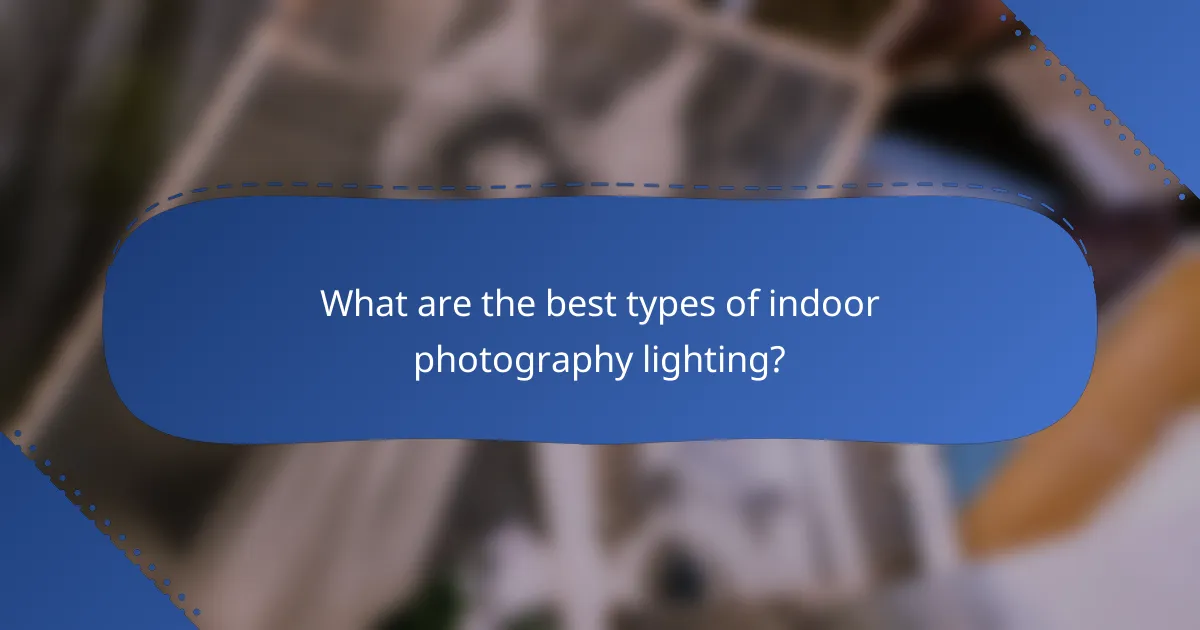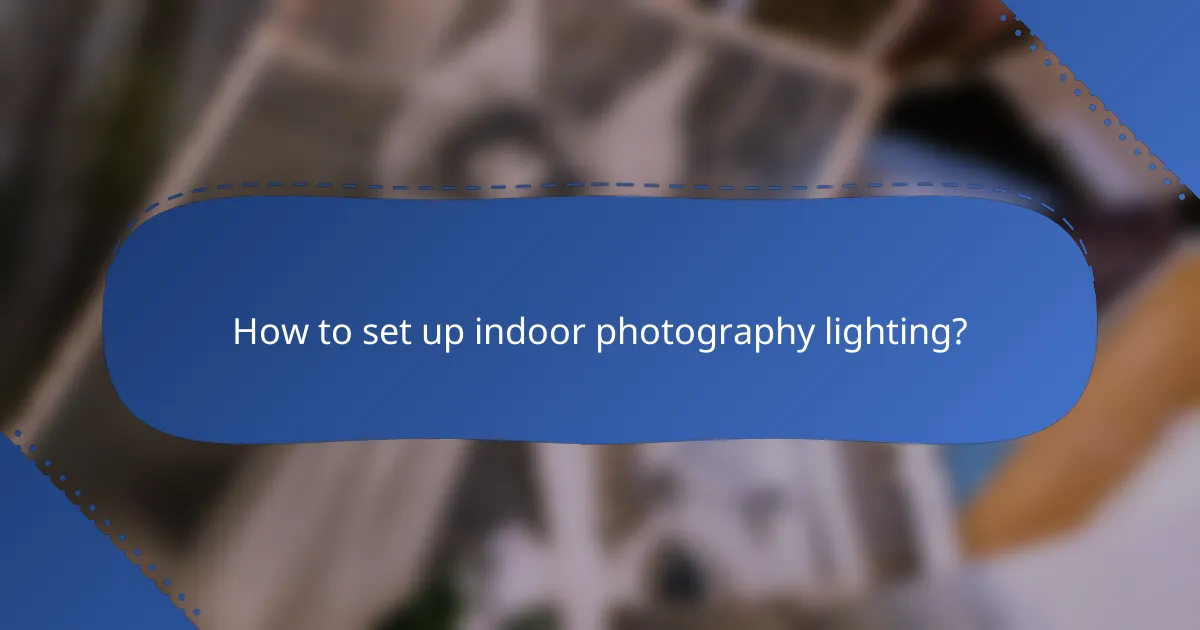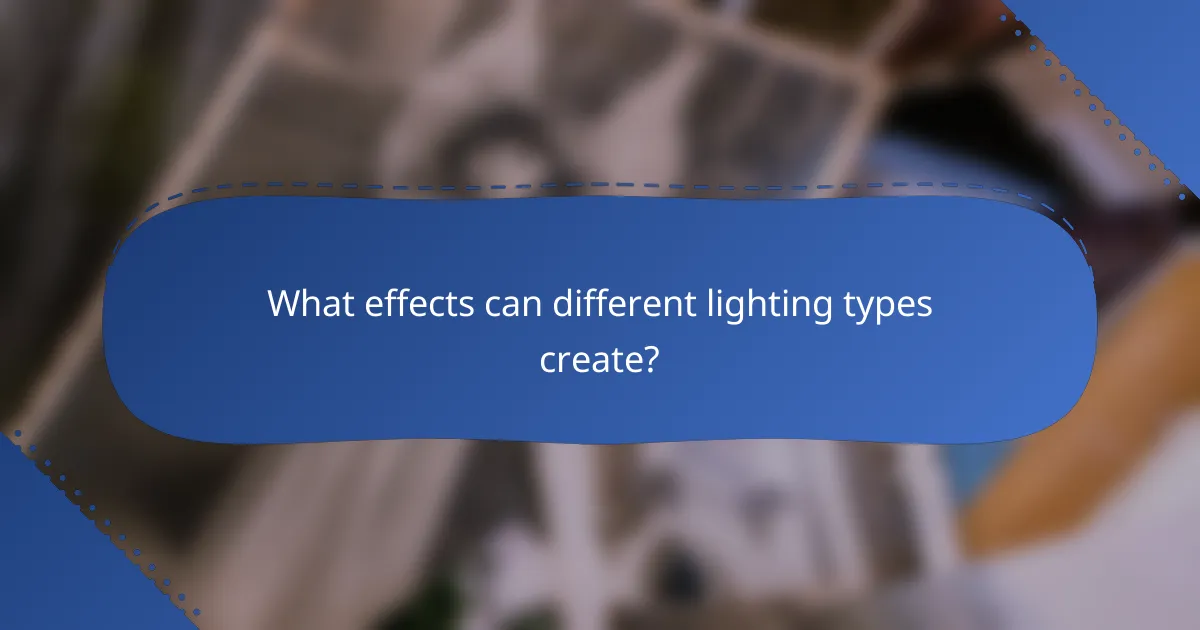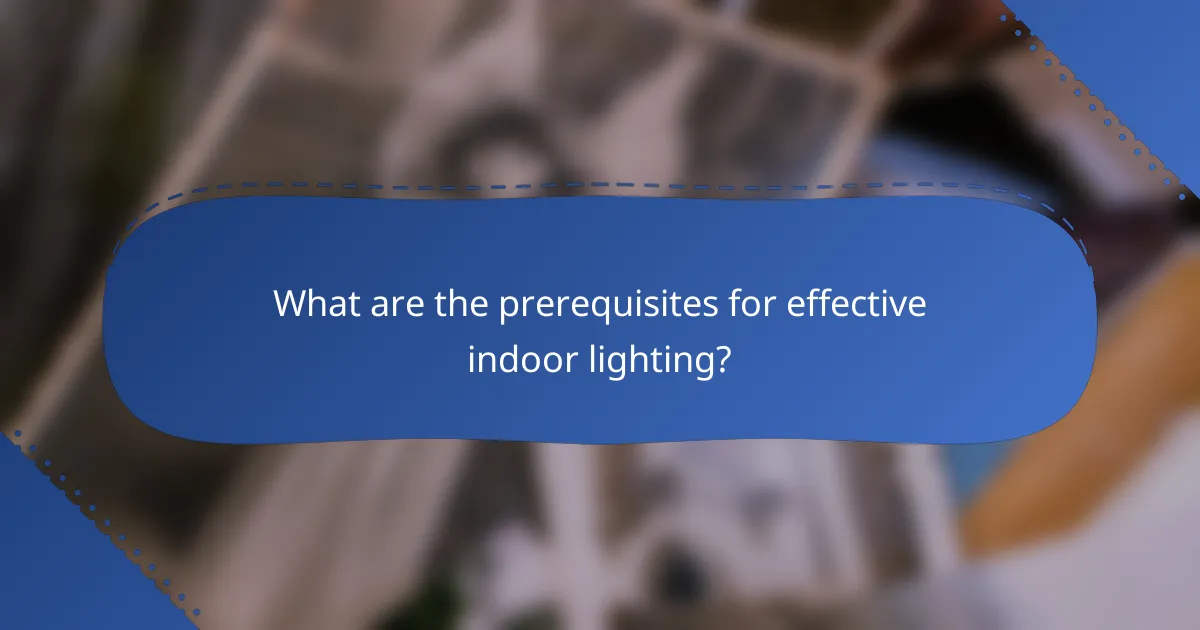Indoor photography lighting plays a crucial role in capturing stunning images, with various types such as continuous lighting, flash, LED, and natural light each offering unique advantages. Proper setup and positioning of these light sources are essential to enhance the subject and create the desired mood. By mastering the effects of different lighting types, photographers can significantly influence the mood, texture, and overall quality of their work.

What are the best types of indoor photography lighting?
The best types of indoor photography lighting include continuous lighting, flash lighting, LED lighting, natural light sources, and softboxes or diffusers. Each type has unique characteristics that affect how images are captured, so understanding their differences is crucial for achieving the desired results.
Continuous lighting
Continuous lighting provides a constant light source, making it easier to see how shadows and highlights will appear in your photos. Common types include tungsten bulbs and fluorescent lights, which can be adjusted to create the desired mood and effect.
When using continuous lighting, consider the color temperature, as it can affect the overall tone of your images. A color temperature around 5500K mimics daylight, while lower temperatures create warmer tones. Always use a light meter or your camera’s histogram to ensure proper exposure.
Flash lighting
Flash lighting delivers a brief burst of light, ideal for freezing motion and achieving sharp images in low-light conditions. Speedlights and studio strobes are popular options, each with varying power and features.
When working with flash, be mindful of the sync speed of your camera, as this determines how fast the shutter can be when using flash. Experimenting with different flash angles and modifiers can help create dynamic lighting effects.
LED lighting
LED lighting is energy-efficient and offers adjustable color temperatures, making it versatile for various indoor photography scenarios. They produce less heat than traditional bulbs, allowing for longer shooting sessions without discomfort.
When selecting LED lights, look for those with a high Color Rendering Index (CRI) to ensure accurate color representation. Many photographers prefer LED panels for their portability and ease of use, especially in tight spaces.
Natural light sources
Natural light sources, such as windows and skylights, can create beautiful, soft lighting for indoor photography. The quality of natural light changes throughout the day, so timing your shoots can significantly impact the results.
To maximize natural light, position your subject near a window and use reflectors to bounce light onto the subject. Be cautious of harsh midday sunlight, which can create unflattering shadows; instead, aim for early morning or late afternoon when the light is softer.
Softboxes and diffusers
Softboxes and diffusers are essential tools for controlling and softening light in indoor photography. They help reduce harsh shadows and create a more flattering light on subjects.
When using a softbox, ensure it is positioned at an angle that complements your subject. Diffusers can be used with both continuous and flash lighting to achieve a similar softening effect. Experiment with different sizes and distances to find the best setup for your specific needs.

How to set up indoor photography lighting?
Setting up indoor photography lighting involves choosing the right types of lights and positioning them effectively to achieve the desired effect. Consider the subject, the mood you want to create, and the available space to optimize your lighting setup.
Basic lighting setup
A basic lighting setup typically includes one or two light sources to illuminate your subject. Common options are continuous lights or speedlights, which provide flexibility for various shooting conditions. For indoor photography, softboxes or diffusers can help soften harsh light and reduce shadows.
When starting, position your main light source at a 45-degree angle to the subject to create depth and dimension. This setup helps to avoid flat lighting and enhances the overall image quality.
Three-point lighting technique
The three-point lighting technique is a standard method that uses three lights: the key light, fill light, and backlight. The key light is the primary source, providing the main illumination, while the fill light softens shadows created by the key light. The backlight adds depth by separating the subject from the background.
To implement this technique, place the key light at a 45-degree angle in front of the subject, the fill light on the opposite side at a lower intensity, and the backlight behind the subject. This arrangement creates a balanced and professional look.
Using reflectors
Reflectors are valuable tools for enhancing indoor lighting by bouncing light onto the subject. They come in various materials, such as white, silver, or gold, each producing different effects. White reflectors provide soft light, while silver reflectors create a more intense, cooler light.
Position the reflector opposite the main light source to fill in shadows and add dimension. Experiment with the distance and angle to achieve the desired effect, ensuring that the light remains flattering and natural.
Positioning lights for effect
Positioning lights effectively can dramatically change the mood and style of your indoor photography. Experiment with different angles and distances to see how they affect shadows and highlights on your subject. For example, placing a light directly above can create dramatic shadows, while a lower angle can produce a more flattering look.
Consider using colored gels or adjusting the intensity of your lights to create specific atmospheres. Always test your setup before the shoot to ensure the lighting complements your subject and enhances the overall composition.

What effects can different lighting types create?
Different lighting types can significantly influence the mood, texture, and overall quality of indoor photographs. Understanding these effects allows photographers to manipulate light to achieve desired artistic outcomes.
Soft vs hard light
Soft light produces gentle shadows and a smooth transition between light and dark areas, creating a flattering effect on subjects. This type of lighting is often achieved using diffusers or softboxes, which scatter light and reduce harshness.
In contrast, hard light creates sharp shadows and high contrast, emphasizing textures and details. This effect can be achieved with direct light sources, such as bare bulbs or sunlight, and is often used for dramatic portraits or architectural photography.
Color temperature effects
Color temperature, measured in Kelvin (K), affects the warmth or coolness of the light in a photograph. Warmer light (around 2500K-3500K) can create a cozy, inviting atmosphere, while cooler light (above 5000K) tends to feel more clinical or stark.
When setting up indoor lighting, consider the color temperature of your sources. Mixing different temperatures can lead to unwanted color casts, so it’s best to use lights with similar color temperatures for consistency.
Shadows and highlights
Shadows and highlights play a crucial role in defining the depth and dimension of a photograph. Properly managing shadows can add drama, while highlights can draw attention to specific areas of the image.
To control shadows, adjust the angle and distance of your light sources. For softer shadows, position lights closer to the subject or use diffusers. Conversely, for more pronounced shadows, move the light further away or use direct lighting. Balancing highlights involves careful exposure settings to prevent overexposure, which can wash out details.

What are the prerequisites for effective indoor lighting?
Effective indoor lighting requires an understanding of light quality, knowledge of exposure settings, and the right equipment. These elements work together to create the desired atmosphere and clarity in your photographs.
Understanding light quality
Light quality refers to the characteristics of light, including its color temperature, intensity, and direction. Soft light, which diffuses shadows, is often preferred for indoor photography, while harsh light can create strong contrasts and unflattering shadows.
To achieve soft light, consider using diffusers or softboxes. These tools can help to spread the light evenly, reducing harshness and enhancing the overall look of your images. Aim for a color temperature between 5000K to 6000K for a natural daylight effect.
Knowledge of exposure settings
Exposure settings determine how much light reaches the camera sensor, affecting brightness and detail. Key settings include aperture, shutter speed, and ISO. A wider aperture (lower f-stop number) allows more light in, which is beneficial in low-light conditions.
For indoor photography, a good starting point is an aperture of f/4 to f/5.6, a shutter speed of 1/60 seconds or faster, and an ISO of 400 to 800. Adjust these settings based on the available light and desired depth of field.
Choosing the right equipment
Selecting the appropriate equipment is crucial for effective indoor lighting. A tripod can stabilize your camera, allowing for longer exposures without blur. Additionally, consider using external flashes or continuous lights to enhance your lighting setup.
When choosing lights, look for LED panels or speedlights that offer adjustable brightness and color temperature. This flexibility can help you match the ambient light in your environment, ensuring consistent results across your shots.
